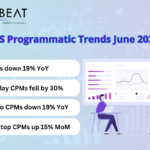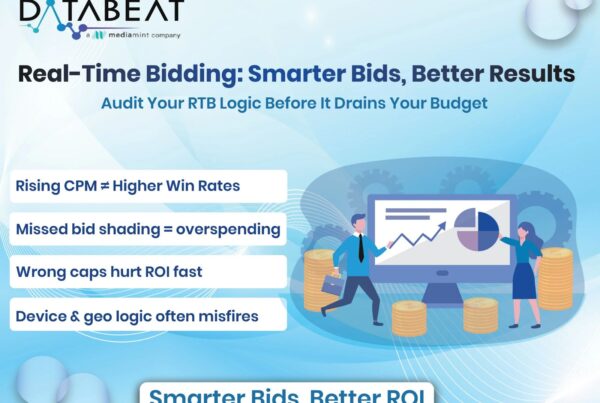
Introduction
In today’s dynamic digital advertising landscape, programmatic advertising is a game-changer for advertisers and publishers. Its automated, data-driven approach enables precise targeting and real-time optimization. However, challenges such as complexity and lack of transparency in the ad-buying ecosystem have led to the need for supply-path optimization (SPO).
So what exactly the SPO is?
Supply Path Optimization (SPO) aims to address the issue of auction duplication that has risen due to the adoption of header bidding in programmatic marketing. Marketers often bid on multiple ad exchanges to achieve broader reach, but they find that many exchanges offer the same inventory for sale. As a result, they may receive an overwhelming number of bid requests, sometimes exceeding 30, for the exact same impression.

Auction Duplication Example (source)
SPO identifies and eliminates auction duplication, considering various factors beyond finding the “most direct” path. Each auction involves varying fees, rules, and speed requirements, contributing to increased campaign costs and reduced predictability for advertisers.
The primary objective of SPO advertising is to help buyers transact with sellers through the most efficient connections, avoiding inefficient or costly supply paths. It benefits both sellers and buyers by building a more transparent supply chain, optimizing the user experience, and increasing trust among all parties in the programmatic auction.
While SPO initially aimed to find the most efficient route to supply, it also considers factors like fees and speed, recognizing that the concept of “direct” can vary.
Industry standards like ads.txt and sellers.json, enforced by the IAB, now require the sell side to disclose their position in the supply chain. “Direct” refers to the exchange paying the publisher directly, while a “reseller” is authorized to sell the inventory but pays the “direct” seller, typically another exchange or ad server with a contractual relationship with the publisher. While removing resellers is one approach for a direct path, it may not always be suitable due to potential higher fees or slower auctions, hindering scalability and performance. Therefore, marketers should seek the most direct, cost-effective, and efficient path to optimize SPO advertising efforts.
How the Advertisers identify the best supply path then?
When implementing supply path optimization (SPO), advertisers seek to improve their path to publisher ad inventory by removing “bad actors” from their media buys on the supply-side platform (SSP) side.
The term “bad actor” in this context encompasses various characteristics. It may refer to an SSP that demands an unusually high take rate or resells impressions on the open web, pocketing the difference in bids. Additionally, SSPs with subpar ad inventory or inadequate safeguards against data leakage may also fall into this category.
Gaining a better understanding of how their advertising budget is allocated allows advertisers to achieve fee transparency and easily track the reasons behind ad placements. This becomes particularly crucial in an era where ads may appear on fraudulent websites or platforms disseminating misinformation.
While one SPO approach involves eliminating the worst sites and SSPs with resold inventory and high fees, another approach focuses on identifying the best options. Advertisers can begin with a curated pool of approved inventory and trusted SSPs, observing if campaigns can deliver performance and scalability without relying on the uncertain world of resold or long-tail supply.
Why should Publishers care about SPO?
According to research by the IAB, 87% of brands, agencies, and DSPs actively implement supply path optimization (SPO). Certain DSPs are already equipped with real-time algorithms to analyze SSPs, enabling them to select relevant ad inventory and adjust bids accordingly. These algorithms also eliminate duplicated bids.
Industry experts predict that SPO advertising features will further evolve and advance in the future. As adtech players embrace SPO, advertisers will be drawn to publishers offering transparent and optimized paths, benefiting publishers in attracting new demand. There is a possibility that advertisers may stop bidding on inventory with multiple ad requests, resulting in a loss for publishers.
While publishers often believe that more SSPs lead to improved yield and revenue, the reality is nuanced. Excessive SSP collaborations can lead to page latency and a decline in user experience, along with hidden fees and charges.
The key lies in finding an optimal balance, not simply working with as many SSPs as possible. Identifying partners with unique demand enables publishers to achieve high yield without compromising user experience.
Benefits of SPO for Publishers
Supply path optimization has the following benefits for the publisher :
1. Transparency: SPO provides full transparency of ad requests and display placements, improving trust between parties.
2. Better Performance and Revenue: Streamlining the supply chain helps publishers receive higher bids, increasing ad revenue without compromising user experience.
3. Fill Rate: SPO algorithms enhance the fill rate by enabling relevant bids on ad inventory.
4. Ad Frauds: Direct supply chains reduce ad fraud risk and associated revenue losses.
5. Latency: Minimizing intermediaries reduces page load times, enhancing user experience.
Conclusion
Supply Path Optimization (SPO) is vital for both advertisers and publishers in the programmatic ecosystem. It brings significant benefits to publishers, positively impacting revenue and relationships with advertisers. By implementing SPO practices, publishers attract advertisers who recognize their value and allocate larger portions of their advertising budgets to achieve better results. Additionally, SPO advertising safeguards ad revenue from fraud and hidden partner fees, ensuring a more efficient and transparent supply chain.
How can DataBeat help?
At DataBeat, we focus on empowering ad tech solutions, and our proficiency extends smoothly to Supply Path Optimization (SPO). With a profound understanding of the intricate ad tech landscape, we harness state-of-the-art technologies and industry insights to refine and improve your supply paths. Our commitment involves providing strategic guidance, tailor-made solutions, and continuous support to ensure that your supply paths are not just efficient but also in sync with your business goals. Join forces with us to navigate the dynamic ad tech ecosystem and unleash the complete potential of your advertising initiatives.









